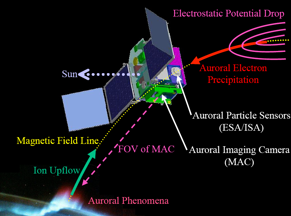EXPERIMENTAL ARRANGEMENT
Three different kinds of measurements contribute to this campaign observations, ground-based radars (EISCAT and SuperDARN), ground-based all-sky TV camera (ATV) and space-based optical and particle measurement (REIMEI spacecraft). Details of the experimental setup are as follows:
EISCAT Incoherent Scatter Radar Facility at Tromsoe
The electron density modulation is directly measured with the EISCAT system at Tromsoe (69.60N, 19.20E in geographic and 66.6E, 103.0E in geomagnetic coordinates), Norway. During the campaign, the UHF system of the EISCAT mainland facility is operative with arc1 pulse scheme along the local field line. Best temporal resolution with this observation mode is 0.44 sec (electron density only).


The VHF system is sometimes used to measure the height profile of the electron deisnty in the lower part of the ionosphere.


The VHF system is sometimes used to measure the height profile of the electron deisnty in the lower part of the ionosphere.
SuperDARN CUTLASS Finland Radar at Hankasalmi
The radar measurements were made by the coherent HF radar located at Hanlasalmi (62.32N, 26.61E in geographic and 59.78N, 105.53E in AACGM magnetic coordinates) in Finland, which forms part of the international Super Dual Auroral Radar Network (SuperDARN). The CUTLASS Finland radar at Hankasalmi was constructed and maintained by Space and Plasma Physics Group, Department of Physics and Astronomy, Univ. of Leicester, UK.

The radar sounds along 16 different beam directions separated by 3.24 deg in azimuth, with the radar boresite pointing at an azimuth of 30 deg (about 45 deg) clockwise from geographic (geomagnetic) north. During the campaign, radar backscatter echoes are gated into 75 range bins, of 15 km in length, with a range of 360 km to the first gate, giving a maximum range of 1485 km (so-called myopic Hankasalmi mode). The 16 beams are scanned clockwise from beam 0 to beam 15 in Channel A with a dwell time of 2 s each. In Channel B, the radar always scans along beam 5, which covers the zenith of ATV at Tromsoe, with a dwell time of 2 s.

The radar sounds along 16 different beam directions separated by 3.24 deg in azimuth, with the radar boresite pointing at an azimuth of 30 deg (about 45 deg) clockwise from geographic (geomagnetic) north. During the campaign, radar backscatter echoes are gated into 75 range bins, of 15 km in length, with a range of 360 km to the first gate, giving a maximum range of 1485 km (so-called myopic Hankasalmi mode). The 16 beams are scanned clockwise from beam 0 to beam 15 in Channel A with a dwell time of 2 s each. In Channel B, the radar always scans along beam 5, which covers the zenith of ATV at Tromsoe, with a dwell time of 2 s.
Ground-based All-Sky TV Camera at Tromsoe
All-sky TV (ATV) camera is operative at Tromsoe (69.60N, 19.20E in geographic and 66.6E, 103.0E in geomagnetic coordinates), which was installed and have been maintained by National Institute of Polar Research (NIPR), Japan as part of optical observation at NIPR hut at Tromsoe



The ATV at Tromsoe is able to record auroral images to videotape at a rate of approximately 30 frames per second. This enables us to image some dynamic nature of aurora with fine temporal resolution. All-sky digital and Wideview TV (WTV) cameras are also operative at Tjornes for support the data from ATV.



The ATV at Tromsoe is able to record auroral images to videotape at a rate of approximately 30 frames per second. This enables us to image some dynamic nature of aurora with fine temporal resolution. All-sky digital and Wideview TV (WTV) cameras are also operative at Tjornes for support the data from ATV.
REIMEI Spacecraft
Japanese small-spacecraft for auroral observation REIMEI was launched in August 2005 and has been operated by ISAS/JAXA, Japan. The spacecraft is on sun-synchronous polar orbit in the noon-midnight (0050-1250LT) meridian at an altitude of 650 km.

The spacecraft carries three CCD cameras for measuring fine scale structures of aurora (Multi-spectral Aurora Camera: MAC), whose wavelengths are N2+ 1NG (427.8 nm), O green line (557.7 nm), N2 1PG (670 nm), respectively. Spatial resolution of the MAC cameras is approximatelly 1 km and exposure interval is 120 ms (Mode-S: normal down-looking observations). FOV coverage is 80 km x 80 km.
The spacecraft also carries electrostatic sensors for precipitating (or up-going) electrons and ions (Electron/Ion Spectrum Analyzer: E/ISA). Specification of the E/ISA can be available here.

The spacecraft carries three CCD cameras for measuring fine scale structures of aurora (Multi-spectral Aurora Camera: MAC), whose wavelengths are N2+ 1NG (427.8 nm), O green line (557.7 nm), N2 1PG (670 nm), respectively. Spatial resolution of the MAC cameras is approximatelly 1 km and exposure interval is 120 ms (Mode-S: normal down-looking observations). FOV coverage is 80 km x 80 km.
The spacecraft also carries electrostatic sensors for precipitating (or up-going) electrons and ions (Electron/Ion Spectrum Analyzer: E/ISA). Specification of the E/ISA can be available here.
